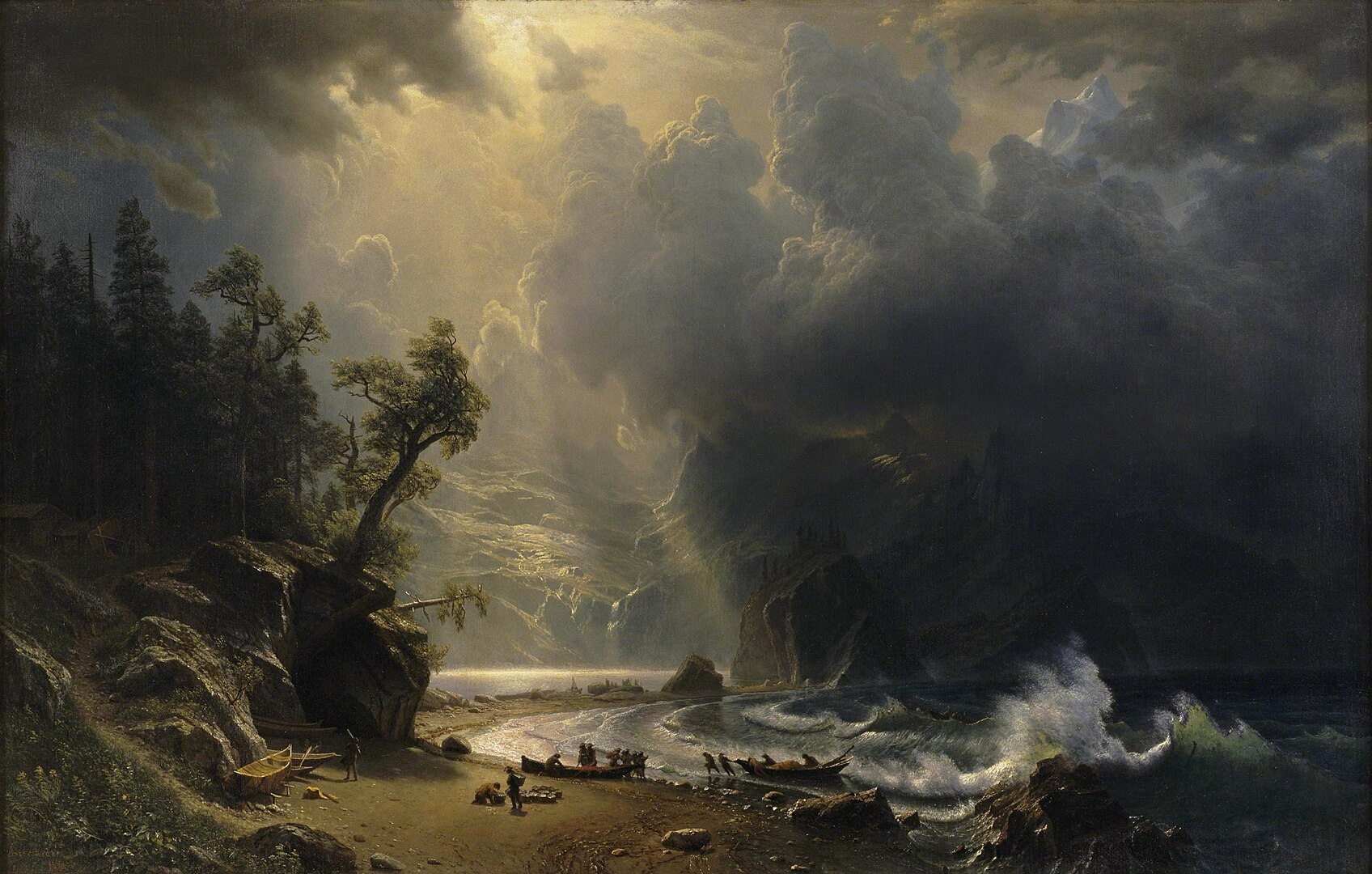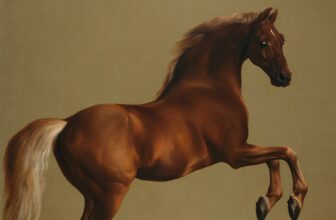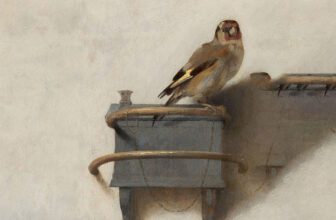
Sound on the Pacific: Albert Bierstadt’s Vision of the Untamed American West
In the vast pantheon of American landscape art, few names shine as luminously as that of Albert Bierstadt. A master of light and grandeur, Bierstadt’s canvases do more than depict landscapes, they elevate them into mythic realms, capturing not only the physical terrain but the spirit of a nation in motion. Among his numerous works that immortalize the American West, one painting stands out for its profound beauty and symbolic resonance: Puget Sound on the Pacific Coast.
But who painted this serene, radiant vision of coastal majesty? Who dared to render the Pacific Northwest, a place then largely mysterious to Eastern eyes, with such poetic clarity? The answer is Albert Bierstadt, and through this painting, he gave the nation not just a glimpse of geography, but a dream of destiny.
The Artist Behind the Canvas
Albert Bierstadt (1830–1902) was born in Germany and emigrated with his family to New Bedford, Massachusetts, as a child. His early life was spent in the heart of the industrializing East, but it was the West, the untamed, unspoiled frontier, that would ultimately seize his imagination and define his legacy.
Bierstadt was a member of the Hudson River School, though he is often more closely associated with the Rocky Mountain School due to his subject matter. Trained in Düsseldorf, Germany, he brought a European sensibility to American subjects. His mastery of light, dramatic compositions, and painstaking detail made him the leading landscape painter of his era, especially known for grand depictions of Western vistas. His works were more than art, they were nationalistic emblems, visual arguments for Manifest Destiny, and romanticized invitations to explore a continent still full of promise.
The Journey to the Pacific
While Bierstadt never visited Puget Sound itself, Puget Sound on the Pacific Coast (painted in 1870) reflects his broader understanding and artistic interpretation of the Pacific Northwest. He drew on sketches, descriptions, and possibly photographs gathered during his travels and through his contacts in government expeditions.
In this period, the West was being opened up by the expansion of the railroad, and artists like Bierstadt served a vital role in conveying the wonders of these remote areas to the general public. These works were often exhibited in grand halls, surrounded by velvet drapes and accompanied by detailed explanations. Viewers would gaze upon them in awe, marveling at places they might never see in person.
A Closer Look: The Content of the Painting
Puget Sound on the Pacific Coast is a sweeping panorama that invites the eye to wander from luminous skies to tranquil waters to majestic, forested cliffs. The composition is both majestic and serene, a typical Bierstadt hallmark. The foreground features a group of Native Americans, some in canoes, others tending to daily tasks near the shore. Their presence gives a sense of life and narrative to the landscape, grounding the scene in the realities of the land’s original inhabitants.
The water itself, calm and glassy, reflects the towering evergreens and snow-capped peaks in the distance. The light, perhaps Bierstadt’s greatest tool, bathes the entire canvas in a golden glow, suggesting not just the time of day but a kind of divine benediction.
It’s a romanticized vision, to be sure. This is not a literal depiction of Puget Sound, but rather an idealized portrayal filtered through Bierstadt’s imagination. Yet it resonates deeply with viewers because it encapsulates so many elements that define the American frontier: vastness, beauty, opportunity, and the tension between untouched nature and encroaching civilization.
What the Painting Represents
Albert Bierstadt’s Puget Sound on the Pacific Coast is a visual symphony of 19th-century American ideals and contradictions. On the surface, it represents the natural beauty of the Pacific Northwest, a place that in 1870 was still being explored and settled. But dig a little deeper, and you uncover layers of meaning that speak to the broader cultural and historical context of the time.
1. The Sublime Landscape
Bierstadt’s work is firmly rooted in the tradition of the sublime, the idea that nature can inspire awe and even terror in the face of its grandeur. His sweeping vistas are designed to dwarf the human presence and exalt the natural world. In this painting, humans are small, almost fragile, compared to the immensity of the sea and forest. Yet they belong here, harmoniously integrated into the landscape.
2. Manifest Destiny and American Expansion
This painting emerged during the height of Manifest Destiny, the belief that it was the divine mission of the United States to expand westward across the continent. Bierstadt’s work often served as propaganda for this ideal, glorifying the land that awaited settlers. Puget Sound on the Pacific Coast presents the Northwest as a paradise, inviting, fertile, and full of promise.
However, there’s an irony here: the inclusion of Native Americans in the painting, while seemingly respectful, also reinforces the idea of an “untouched” land ready for white settlement. The indigenous people are shown as part of a noble but fading world, soon to be overtaken by the tide of progress. It’s a beautiful but bittersweet narrative.
3. Harmony Between Man and Nature
Unlike some of Bierstadt’s other works that depict dramatic natural disasters or rugged, impassable terrain, Puget Sound conveys a sense of harmony. The Native Americans are not at odds with their environment; they are an integral part of it. This peaceful coexistence serves as both a historical reflection and a philosophical ideal, one that would soon be shattered as industrialization and settlement accelerated.
Symbolism and Artistic Technique
Bierstadt was a master of theatrical composition. His use of light, in particular, is symbolic. In this painting, the golden illumination suggests more than sunset, it hints at revelation, a dawning of new understanding. The light breaks through the clouds much like divine inspiration breaking through ignorance. It’s as if the West is being unveiled, not just to the eye, but to the soul.
His brushwork, though often criticized by later generations as overly polished or romanticized, was meticulous. Every tree, wave, and cloud is rendered with loving precision. The effect is a hyper-realism that paradoxically feels more idealized than real. It’s an America not as it was, but as it could be, or as people wanted to believe it was.
The juxtaposition of land, sea, and sky also plays a significant role. The water serves as a mirror, reflecting not only the trees and mountains but the viewer’s aspirations. The land is fertile, ready for planting and settlement. The sky is limitless. All of it combines to deliver a message of potential and peace.
Where Is the Painting Today
Puget Sound on the Pacific Coast currently resides at the Seattle Art Museum in Seattle, Washington. It’s a fitting home for the painting, a modern metropolis built upon the very landscape Bierstadt sought to enshrine. The painting now exists not just as art but as a historical artifact, a reminder of how Americans once viewed the land that would become the state of Washington.
Visitors to the museum can stand before the canvas and be transported, not just to a different place, but to a different time, when the West was still a mystery and a promise. It is a rare opportunity to see not only what the landscape looked like, but how it felt in the national imagination.
Legacy and Relevance Today
What makes Puget Sound on the Pacific Coast enduringly relevant is its ability to speak across time. In an age where we grapple with environmental destruction, indigenous rights, and cultural preservation, Bierstadt’s painting prompts reflection. It asks us to reconsider what was gained, and what was lost, during the great westward expansion.
Modern critics may question the idealization of the Native figures, or the erasure of violence and displacement in Bierstadt’s vision. But there’s also a power in the dream he painted: a harmonious world where nature and humanity exist in balance. Perhaps it’s an aspiration still worth pursuing.
In the end, Albert Bierstadt was not just painting mountains and forests. He was painting a nation’s soul, caught at the cusp of transformation. His Puget Sound on the Pacific Coast remains a masterpiece not just of art, but of mythmaking. It is as much about vision as it is about place.
So the next time you find yourself in Seattle, take a detour into the past. Stand before Bierstadt’s great canvas, and listen closely. You might just hear the sound of the Pacific, the echo of dreams, distant but not forgotten.




